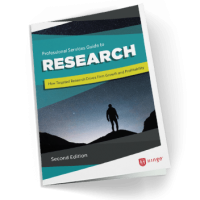Strategically developing your brand, and enhancing its value, helps to foster strong relationships with clients and prospects, thus building a stronger path to new business. But developing a brand is only the beginning. Managing it is a continuous, and often challenging process.
In this post, I will review some common brand management challenges and address which research methods are right for the job.
What are the biggest brand management challenges?
Managing a brand requires an understanding how it’s perceived from multiple vantage points: internally (staff, leadership) and externally (prospects, clients, competitors, referral sources). It’s easy for a once-harmonious brand message to go out of tune.
Consider some of the challenges brand managers face:
- Convincing leadership that brand management is worth the investment
- Measuring brand awareness in the target market
- Differentiating their firm from competitors
- Crafting a positioning statement
- Unifying internal and external brand messages
- Keeping a consistent message across marketing channels
- Building a digital brand strategy
- Upgrading brand logos and other graphics
Addressing these issues requires a deep understanding of both your target clients and employees. This is why many professional services firms turn to research to help manage their brand.
How can research impact brand management?
Mergers, acquisitions, and firm anniversaries are common situations when a firm might reassess it’s brand strategy. However, the professional services marketplace can evolve quickly — offering growth opportunities for the firms that can recognize them, but making brand management difficult.
Our latest research on high-growth professional services shows that research is the fourth-most impactful marketing technique, falling behind only providing assessments, keyword research/SEO, and live product/service demonstrations.
When it comes to high-growth firms, they are more than twice as likely to conduct research on their target market when compared to firms with no growth. Not only are high-growth firms more likely to conduct research, they also conduct research at a more frequent pace.
This proactive, inquisitive approach helps these high-growth firms anticipate behavioral changes in target markets—allowing them to stay relevant and contributing to their success.
What research methods make the most sense?
The research method that is best for you will depend on the brand management challenges you need to address. For instance, brand awareness in a target market may be best measured using quantitative methods, such as surveying or polling. On the other hand, redesigning a logo and crafting relevant positioning and messaging require more of a qualitative approach.
Quantitative Research Methods
Quantitative research focuses on objective, empirical measurements and statistical analysis. Common data collection methods include the use of surveys (both digital and print), polling, interactive quizzes, and in-depth interviews.
Quantitative methods — such as examining the perception gap between clients and employees — can uncover differentiators, competitive strengths, and opportunities for improvement.
For example, suppose that through a client survey you find the majority of clients believe your firm is best known for flexibility and responsiveness. Internally, employees didn’t mention this. In this instance, the quantitative method of comparing external and internal respondent ratios has uncovered a potential differentiator.
Quantitative methods can also be useful when measuring marketing metrics like Net Promoter Score, the probability of referrals, and brand strength index. These metrics are valuable alone, but can be taken to a new level when tracked over time.
Qualitative Research Methods
The creative side of branding is especially effective when grounded in research. Qualitative research methods — like observing client behavior in real time, focus groups, and in-depth interviews — are a great way to take a raw brand direction and smooth it out.
You could, for instance, couple a quantitative survey with in-depth interviews of the types of clients you want more of. A talented interviewer can probe and extract language that might inform the way you describe your differentiators.
An Integrated Approach
In-depth interviews are a great way to balance quantitative and qualitative research methods. Add in an online survey of your internal staff and you have an integrated approach that will yield actionable insights that help address common brand management challenges.
For professional services firms, combing research methods has proven to be a successful formula. And client interviews provide an added benefit: they demonstrate that you value your clients’ perspectives and are interested in improving your overall client experience.
How Hinge Can Help
Brand research gets to the core of what will resonate with those audiences—and is an integral part of what Hinge does for clients. Learn more about our research services or contact us to learn whether research makes sense for your professional services firm.
Additional Resources
- Our Professional Services Guide to Research gives you the tools and knowledge you need to lead your firm through conducting research.
- Develop a stronger and more valuable brand with Hinge’s Brand Building Guide for Professional Services Firms.
- Uncover your firm’s true differentiators and give buyers a reason to pick you out of the crowd in Differentiation, Positioning & Messaging through Hinge University.


